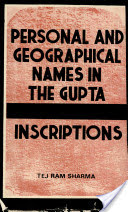Tej Ram Sharma

Tej Ram Sharma is author of the book -
Personal and geographical names in the Gupta inscriptions.
Publisher: Concept Publishing Company Delhi, 1978
The need
Considering the rich possibilities in a historical and comparative analysis of the name-patterns, it is surprising indeed that, with a few singular exceptions, historians have not paid to this area of study the serious attention it deserves. Obviously this type of study is more demanding in respect of the disciplines involved. The historian, who undertakes the work, has to possess a comprehensive knowledge of different aspects of an ancient society. He has to combine a knowledge of Sanskrit grammar and linguistics with a proficiency in palaeography and competence to handle the original texts bearing on the subject.
Author's contribution
Dr. Tej Ram Sharma assiduously cultivated the qualities and acquired the necessary command over the concerned disciplines. It is gratifying to find that Dr. Sharma has produced a first-rate study on the subject and has covered himself up with glory.
The study of the Gupta period of Indian history has been enriched by the contributions of many a competent scholar. But, without there being any significant addition to the original sources, some of the many publications have only been reproducing already well-known material. The approach adopted in these studies being regularly repetitive has acquired a chilling monotonousness. Dr. Sharma deserves commendation for attempting an analysis of the culture of the Gupta period from an altogether new angle. His fresh approach has imparted a living warmth to the socio-cultural life of the period. Dr. Sharma has definitely made significant improvement upon our understanding of the Classical Age of Indian history.
About Author
Tej Ram Sharma started his teaching career at Himachal Pradesh University Shimla, presently teaches History at the University of Hyderabad. He has served the University of Hyderabad for over two decades where he has been a founder member of the Department, Head of the Department of History, Dean of the School of Social Sciences and the Member of the Executive Council. He has participated. Organised, chaired and inaugurated many conferences and seminars of inter-disciplinary nature. He is a member of many National and international professional bodies. He has won wide acclaim form scholars for his earlier works and the prestigious awards conferred on him form the International Academic Community bear the stamp of a wider recognition of his scholarship. Presently he is working as a Professor in the Department of History and Coordinator of SAP-3, DSA-Department of History, University of Hyderabad.
His other books
- Itihas me Shodh vidhi(Hindi) - Year of Publication : 2005, ISBN 8180690075, No of Pages : X, 137, Price : Rs.225.00
- Political History of Imperial Guptas (A): From Gupta to Skand Gupta- Year of Publication: 1989, ISBN 8170222516, Language : English, No of Pages: XV, 213, Price : Rs.150.00
- Research Methodology in History - Year of Publication : 2001, ISBN 8170228271, Language :English, No of Pages : 164, Price : Rs.250.00
- Historiography: A History of Historical Writing - Year of Publication : 2005, ISBN : 8180691551, Language : English, No of Pages : XII, 188, Price : Rs.500.00
On Jat origin of Guptas
Poona Plates of 13th year of Prabhavatigupta reveal the Gotra of Prabhavatigupta to be Dharan which is a Jat clan. In this context we must note that Prabhavatigupta, the daughter of Chandragupta II and chief queen of the Vakataka king Rudrasena II describes herself as belonging to the Dharan gotra in her Poona and Riddhapur copper plate inscriptions. Dharana is clearly the gotra of her father. Hence we see that Chandragupta II was of Dharan Gotra Jat. See details at - Prabhavatigupta.
K P Jayaswal takes it to stand for Dharan, a Jat clan found in Amritsar, and on the basis of the Kaumudimahotsava he concludes that Chandragupta I was a Karaskara or Kakkar Jat. [1] This view has been supported by B.G. Gokhale.[2]
Tej Ram Sharma[3] writes that Jayaswal emphasizes the similarity between the name of the Dharaniya Jats in Ganganagar district of Rajasthan and the Dharana gotra of the Guptas.[4] Chandragomin's grammatical illustration "ajayat jarto Hunan" (The Jarta or Jat king defeated the Hunas) has also been interpreted by Jayaswal to refer to the Gupta ruler Skandagupta's victory over the Hunas. Thus the Jat origin of the Guptas has been a favourite thesis of Jayaswal. Hoernle while identifying the people with Jats interprets the passage as referring to the defeat of the Hunas by Yasodharman.
External links
Back to Jat Historians
- ↑ Tej Ram Sharma:Personal and geographical names in the Gupta inscriptions, pp. 16-17
- ↑ B.G. Gokhale, Samudragupta, Life and Times, pp. 25-26.
- ↑ Personal and geographical names in the Gupta inscriptions/Names of the Gupta Kings and Queens,p.17
- ↑ Journal of Bihar and Orissa Research Society, Patna, 1934, p. 235.

